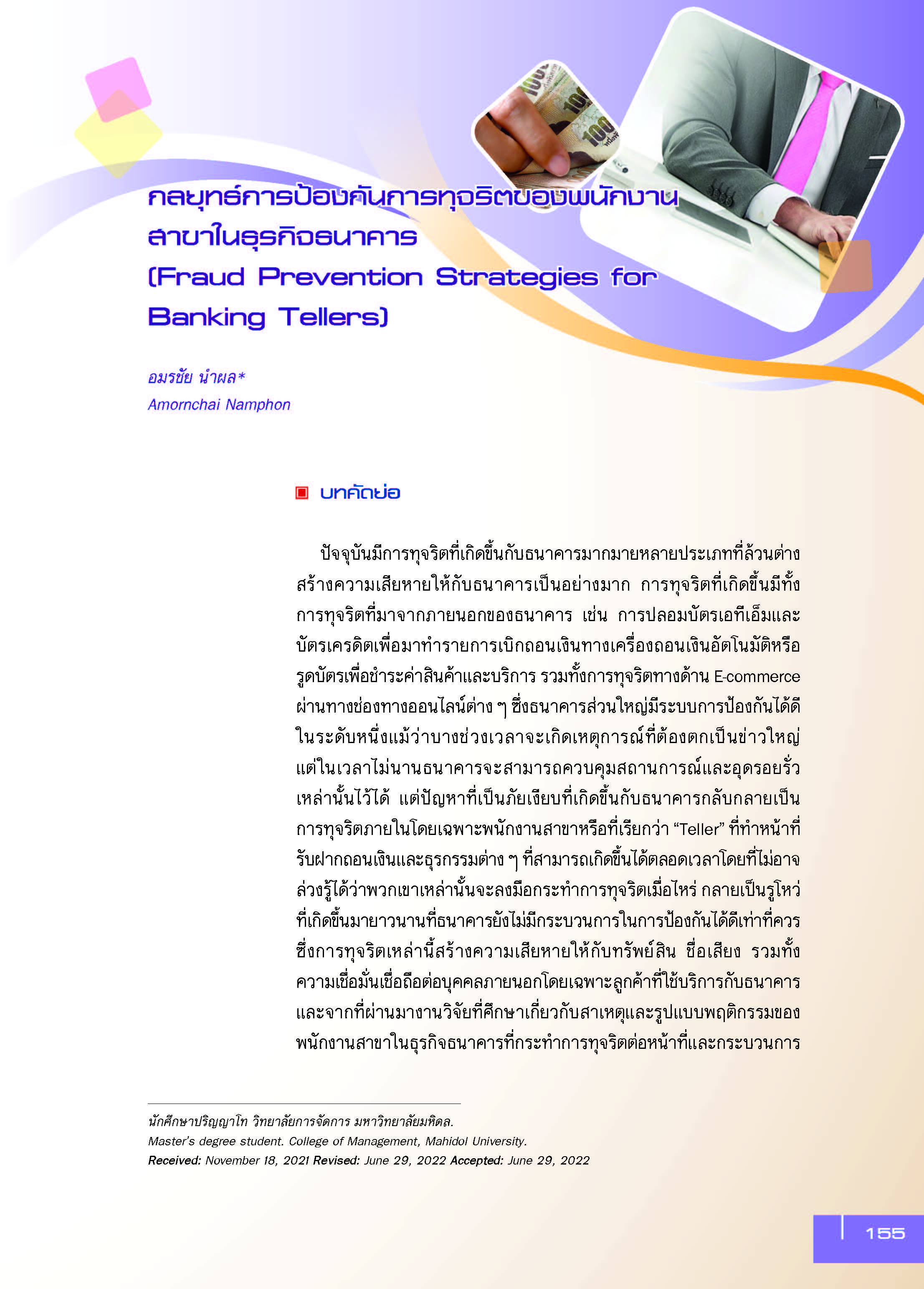กลยุทธ์การป้องกันการทุจริตของพนักงานสาขาในธุรกิจธนาคาร
Main Article Content
บทคัดย่อ
ปัจจุบันมีการทุจริตที่เกิดขึ้นกับธนาคารมากมายหลายประเภทที่ล้วนต่างสร้างความเสียหายให้กับธนาคารเป็นอย่างมาก การทุจริตที่เกิดขึ้นมีทั้งการทุจริตที่มาจากภายนอกของธนาคาร เช่น การปลอมบัตรเอทีเอ็มและบัตรเครดิตเพื่อมาทำรายการเบิกถอนเงินทางเครื่องถอนเงินอัตโนมัติหรือรูดบัตรเพื่อชำระค่าสินค้าและบริการ รวมทั้งการทุจริตทางด้าน E-commerce ผ่านทางช่องทางออนไลน์ต่าง ๆ ซึ่งธนาคารส่วนใหญ่มีระบบการป้องกันได้ดีในระดับหนึ่งแม้ว่าบางช่วงเวลาจะเกิดเหตุการณ์ที่ต้องตกเป็นข่าวใหญ่ แต่ในเวลาไม่นานธนาคารจะสามารถควบคุมสถานการณ์และอุดรอยรั่วเหล่านั้นไว้ได้ แต่ปัญหาที่เป็นภัยเงียบที่เกิดขึ้นกับธนาคารกลับกลายเป็นการทุจริตภายในโดยเฉพาะพนักงานสาขาหรือที่เรียกว่า “Teller” ที่ทำหน้าที่รับฝากถอนเงินและธุรกรรมต่าง ๆ ที่สามารถเกิดขึ้นได้ตลอดเวลาโดยที่ไม่อาจล่วงรู้ได้ว่าพวกเขาเหล่านั้นจะลงมือกระทำการทุจริตเมื่อไหร่ กลายเป็น รูโหว่ที่เกิดขึ้นมายาวนานที่ธนาคารยังไม่มีกระบวนการในการป้องกันได้ดีเท่าที่ควร ซึ่งการทุจริตเหล่านี้สร้างความเสียหายให้กับทรัพย์สิน ชื่อเสียง รวมทั้งความเชื่อมั่นเชื่อถือต่อบุคคลภายนอกโดยเฉพาะลูกค้าที่ใช้บริการกับธนาคาร และจากที่ผ่านมางานวิจัยที่ศึกษาเกี่ยวกับสาเหตุและรูปแบบพฤติกรรมของพนักงานสาขาในธุรกิจธนาคารที่กระทำการทุจริตต่อหน้าที่และกระบวนการป้องกันนั้นมีไม่มาก ดังนั้น ผู้วิจัยจึงพบช่องว่างในการทำการวิจัยในเรื่องดังกล่าว ซึ่งบทความนี้เป็นส่วนหนึ่งของสารนิพนธ์ที่ผู้เขียนศึกษาในระดับปริญญาโทสาขาการจัดการและกลยุทธ์ มหาวิทยาลัยมหิดล โดยเป็นการวิจัยเชิงคุณภาพ ผ่านการสัมภาษณ์เชิงลึก (in-dept interview) จากผู้มีประสบการณ์ในการพิจารณากรณีการทุจริตของพนักงานสาขาในธุรกิจธนาคารทั้งหมด 19 ท่าน จาก 4 ธนาคารเอกชน และข้อมูลการทุจริตภายในของพนักงานสาขาในธุรกิจธนาคารที่ไม่สามารถเปิดเผยได้ ผลการศึกษาพบว่า รูปแบบการทุจริตต่อธนาคารที่พบได้บ่อยที่สุด คือ การโอนเงินลอยหรือฝากเงินลอยเข้าบัญชีโดยไม่มีตัวเงินจริง รองลงมาเป็นการลักเงินเกินจากการสรุปยอด ณ สิ้นวัน ส่วนรูปแบบการทุจริตต่อลูกค้าที่พบได้บ่อยสุด คือ การแอบถอนเงินจากบัญชีที่ไม่เคลื่อนไหวมานานและบัญชีฝากประจำ รองลงมาเป็นการแอบยกเลิกรายการฝากเงินหรือชำระเงิน (error collection) โดยปัจจัยที่ทำให้พนักงานกระทำการทุจริต มี 3 องค์ประกอบ ได้แก่ (1) เกิดจากแรงกดดัน จากปัญหาการเงิน เช่น การหลงใหลในการเล่นการพนัน ปัญหาหนี้สิน ภาระค่าใช้จ่ายในครอบครัว ความอยากได้อยากมี ที่นำไปสู่การทวงหนี้ทั้งในระบบและนอกระบบ และความเครียดจากผลงานในการทำงาน (2) เกิดจากโอกาสและช่องโหว่ที่เอื้อต่อการทุจริต เช่น ความไว้วางใจของลูกค้าโดยลูกค้าจะฝากสมุดบัญชีหรือเอกสารที่เกี่ยวกับธุรกรรมของตนไว้กับพนักงานบางคนที่ตนเองไว้ใจ ส่วนความไว้ใจของหัวหน้างานที่มีต่อตัวพนักงานมักจะเกิดจากการที่ผู้บริหารสาขามองหาพนักงานในสาขาที่มีลักษณะที่สามารถไว้วางใจได้ สุขุม และสนิทสนมเพื่อที่จะมาช่วยดูแลงานในบางกระบวนการเมื่อตนเองไม่อยู่หรือเมื่อจำนวนพนักงานในสาขาไม่พอกับการรับบริการลูกค้า โดยมีการฝากรหัสรับรองการทำรายการซึ่งเป็นกุญแจสำคัญ ในการแก้ไขรายการหรือทำธุรกรรมที่มีความเสี่ยงเกินอำนาจในตำแหน่งของพนักงานรายนั้นรับผิดชอบ รวมทั้งมอบหมายงานหลาย ๆ หน้าที่ให้กับพนักงานที่ไว้ใจได้เพียงคนเดียวดูแลงานทั้งหมดของสาขา และ (3) เกิดจากการหาเหตุผลเข้าข้างตัวเอง เช่น การรู้สึกว่าธนาคารปฏิบัติกับตนไม่เป็นธรรมจึงต้องทุจริตคืนเพื่อลบล้างความรู้สึกผิดในใจหรือคิดว่าทำไปแล้วธนาคารไม่ได้รับความเสียหาย เช่น เวลาพนักงานผิดพลาดทำเงินขาดไม่สามารถกระทบยอดเงิน ณ สิ้นวันทำการได้ตรง พนักงานยังต้องควักเงินตัวเองหรือโดนหักเงินเดือนเพื่อชดใช้เงินคืนให้กับธนาคารแต่ถ้าเงินเกินจากในระบบเล็กน้อยก็ขอเก็บเป็นเงินส่วนตัวเพื่อถัวเฉลี่ยจากตอนที่ทำเงินขาด เป็นต้น ซึ่งปัจจัยในการทุจริตทั้ง 3 องค์ประกอบอาจมีปฏิสัมพันธ์กันในการลงมือกระทำการทุจริต ซึ่งสอดคล้องกับทฤษฎีสามเหลี่ยมการทุจริต (Fraud Triangle Theory) ของ Donald Cressey (Cressey, 1953)
สำหรับแนวทางในการป้องกันการทุจริตของพนักงานสาขาในธุรกิจธนาคารสามารถทำได้ทั้งการให้รางวัลหรือให้ความช่วยเหลือและการป้องกันที่เป็นบทลงโทษ เพื่อเป็นการสร้างสมดุลทางพฤติกรรมของพนักงาน ซึ่งสามารถแบ่งออกเป็น 2 แบบ ได้แก่
1. กลยุทธ์ที่เน้นก่อนการทุจริต ได้แก่ การป้องกันก่อนเกิดธุรกรรมทางการเงิน แบ่งเป็น 5 องค์ประกอบ ได้แก่ (1) การวางกฎระเบียบและนโยบายให้รัดกุมห้ามให้พนักงานคนเดียวทำหน้าที่หลายหน้าที่อย่างเบ็ดเสร็จ มีการวางกฎในการลงโทษอย่างเด็ดขาดกับผู้บริหารสาขาในเรื่องความบกพร่องในการตรวจรายงานประจำวันและการรักษารหัสรับรองรายการ ควรมีการให้รางวัลสำหรับพนักงานที่แจ้งเบาะแสจากพฤติกรรมของเพื่อนร่วมงานที่ส่อไปในทางทุจริต (2) การป้องกันด้วยการจัดสถานที่ในสาขาให้อยู่ในที่โล่งแจ้ง ตำแหน่งโต๊ะทำงานและหน้าจอคอมพิวเตอร์ของพนักงานสาขาต้องอยู่ในสายตาที่ผู้บริหารมองเห็น กล้องวงจรปิดควรมีความละเอียดสูง สามารถเห็นบรรยากาศภายในสาขาได้อย่างทั่วถึงทุกซอกทุกมุม (3) การสร้างวัฒนธรรมย่อยในสาขา ผู้จัดการสาขาต้องทำให้พนักงานในสาขาเข้าถึงได้ ปรึกษาพูดคุยได้ทุกเรื่องทั้งเรื่องส่วนตัว เรื่องครอบครัว และเรื่องปัญหาการทำงาน ลดความเข้มงวดในการขายผลิตภัณฑ์ของธนาคารโดยการใช้ทีมขายโดยเฉพาะแทนพนักงานเคาน์เตอร์ (4) การเพิ่มศักยภาพในการทำงานและการใช้ชีวิตที่ดีขึ้น โดยธนาคารต้องดูแลและพิจารณาในเรื่องค่าตอบแทนให้สัมพันธ์กับค่าครองชีพในปัจจุบันและควรเพิ่มการจัดการอบรมเรื่องจริยธรรมให้แก่พนักงาน ให้คำแนะนำและความรู้ในการเข้าถึงและการใช้สวัสดิการเงินกู้ต่าง ๆ และ (5) การควบคุมการใช้รหัสรับรองรายการ โดยการนำนวัตกรรมเข้ามาช่วยในกระบวนการทำงานด้วยการสร้าง Application ไว้ให้พนักงานระดับสูงรับรองรายการนอกสถานที่หรือการใส่รหัสพร้อมกับการแตะบัตรพนักงานและการสแกนใบหน้า รวมทั้งจัดตั้งหน่วยงาน Central Authorize หรือหน่วยงานกลางที่ทำหน้าที่อนุมัติรายการที่มีความเสี่ยงแทน
2. กลยุทธ์ที่เน้นให้เกิดขึ้นในกระบวนการอย่างต่อเนื่อง เป็นการป้องกันหลังเกิดธุรกรรมทางการเงิน แบ่งเป็น 2 องค์ประกอบ ได้แก่ (1) การใช้ระบบโปรแกรมและระบบการแจ้งเตือนโดยมีระบบแจ้งเตือนแบบทันทีทันใด (real time) ไปยังลูกค้า รวมไปถึงมีระบบทีมงานที่ทำหน้าที่ตรวจจับธุรกรรมจากพนักงานสาขาโดยตั้งเป็นเงื่อนไขจากกรณีที่เกิดการทุจริตเป็นประจำและตรวจจับการตรวจรายงานประจำวันของผู้บริหารสาขา และ (2) การใช้ผู้เชี่ยวชาญ เพิ่มการสุ่มตรวจสอบ (surprise check) จากฝ่ายตรวจสอบภายในและเมื่อเกิดกรณีการทุจริตไม่ว่าจะเป็นการทุจริตที่มีมูลค่าเล็กน้อยก็ตามต้องมีหน่วยงานเฉพาะที่มีอำนาจเบ็ดเสร็จในการสืบสวนสอบสวนพนักงาน เพื่อป้องกันการช่วยเหลือพนักงานที่ทำความผิด
Article Details

อนุญาตภายใต้เงื่อนไข Creative Commons Attribution-NonCommercial-NoDerivatives 4.0 International License.
ต้นฉบับที่ได้รับการตีพิมพ์ในวารสาร เป็นลิขสิทธิ์ของวารสารกระบวนการยุติธรรม แต่ความคิดเห็นที่ปรากฏในเนื้อหาของบทความในวารสารกระบวนการยุติธรรม ถือเป็นความรับผิดชอบของผู้เขียนแต่เพียงผู้เดียว
เอกสารอ้างอิง
กรมตรวจสอบบัญชีสหกรณ์. (2554). การควบคุมภายใน. ค้นเมื่อ 24 มิถุนายน 2565, จาก https://www.cad.go.th/download/1_3control.pdf
กรุงเทพธุรกิจ. (2565). ส่องจำนวนสาขาธนาคารในไทย เพิ่มขึ้น-ลดลงแค่ไหนในรอบ 1 ปี?.ค้นเมื่อ 23 มิถุนายน 2565, จาก https://www.bangkokbiznews.com/business/989551
กฤษฎาธาร คชาธาร. (2565). วิกฤตและโอกาสของพนักงานธนาคารในยุคดิจิตอล. ค้นเมื่อ 23 มิถุนายน 2565, จาก https://www.depa.or.th/th/article-view/bank-employees-in-the-digital
ณพวุฒิ โพธิ์หอม. (2560). อุปกรณ์แจ้งเตือนอัตโนมัติผ่าน Line, SMS และ E-mail. สารนิพนธ์วิศวกรรมศาสตรมหาบัณฑิต. มหาวิทยาลัยธุรกิจบัณฑิตย์.
พัชราภรณ์ ดวงชื่น. (2560). บทบาทของผู้ตรวจสอบภายในต่อการจัดการความเสี่ยงขององค์กรในยุคไทยแลนด์ 4.0. กรุงเทพฯ: มหาวิทยาลัยคริสเตียน.
สำนักงานปลัดกระทรวงเกษตรและสหกรณ์, สำนักพัฒนาระบบบริหาร. (2555). การวิเคราะห์วัฒนธรรมองค์การ. ค้นเมื่อ 24 มิถุนายน 2565, จาก https://www.opsmoac.go.th/km-km_org_center-files--391991791962
Antifraud.in.th (2020). “ความเชื่อผิด ๆ เกี่ยวกับการทุจริตองค์กร (ตอนที่ 1)”.สืบค้นเมื่อ 14 กุมภาพันธ์ 2564, จาก https://www.blockdit.com/posts/5cad6990f95b010ffc60ba67.
Cressey, D. R. (1953). Other people's money; A study of the social psychology of embezzlement. Glencoe: Free Press.
Kelly, A. E. (1999). Revealing personal secrets. Current Directions in Psychological Science, 8 (4), 105-109.
Reith, G. (2006). Research on the social impact of gambling. Retrieved January 21, 2021, from https://www.webarchive.org.uk/wayback/archive/20150220161659/http://www.gov.scot/Publications/2006/08/17134534/1


